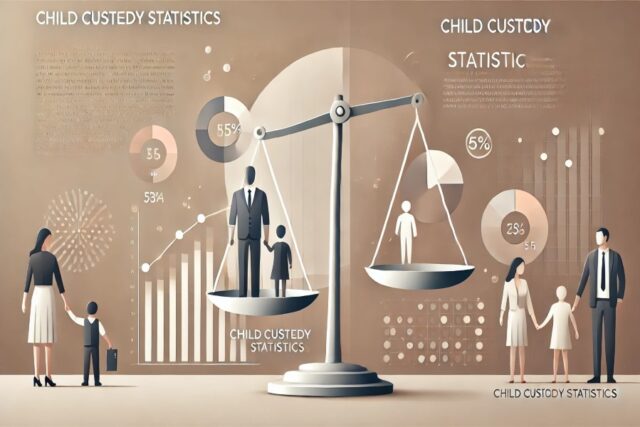Child custody statistics reveal that state laws vary when it comes to determining custody arrangements, but the general standard is that the best interests of the child must be considered. However, these factors often tend to favor mothers, resulting in a higher likelihood of mothers winning custody.
This bias in favor of mothers is evident in the statistics, with women being more likely to win custody battles. It is important to note that these statistics may vary depending on the specific circumstances and jurisdiction. Nonetheless, understanding these statistics can provide valuable insights into the current trends in child custody arrangements in the United States.
Current Custody Distribution Trends
Current custody distribution trends show that the majority of custody awards are still granted to mothers, as courts prioritize the best interests of the child. State laws vary, but factors generally favoring mothers. However, there’s an increasing recognition of the importance of involving both parents in the child’s upbringing.
Current Custody Distribution Trends
Child custody is a complicated issue that can arise during a divorce or separation. In the United States, custody laws vary by state, but the general standard used today is that the custody award must be in the “best interests of the child.” Custody can be awarded to one parent (sole custody) or both parents (joint custody).
Custody Statistics by Gender
According to national child custody statistics by gender, mothers are more likely to be awarded custody than fathers. In fact, over 80% of custodial parents are mothers. This is due to the fact that the factors that courts consider in determining custody arrangements are more likely to favor mothers, such as the child’s age and gender, the primary caretaker of the child, and the child’s relationship with each parent.
Custody Outcomes by State
Custody outcomes by state vary widely, but in general, mothers are more likely to be awarded custody than fathers. However, there are some states where fathers are more likely to be awarded custody, such as Iowa, Kansas, and South Dakota. In these states, fathers are awarded custody in more than 50% of cases.
It’s important to note that custody outcomes can also be influenced by other factors such as the age of the child, the child’s preference, and the parents’ ability to provide a stable home environment.
In conclusion, child custody is a complex issue that varies by state and is influenced by many factors. While mothers are more likely to be awarded custody, fathers can still be awarded custody in certain circumstances and in certain states. It’s important for parents to work with a qualified family law attorney to ensure that their custody rights are protected and that the best interests of their children are being served.
Factors Influencing Custody Decisions
When it comes to child custody decisions, various factors come into play, influencing the final outcome. Understanding these factors is crucial for anyone navigating the complexities of custody arrangements.
Best Interests Of The Child Standard
The “best interests of the child” standard is the primary guiding principle used by courts in determining custody arrangements. This standard focuses on the well-being and needs of the child, prioritizing factors that promote the child’s overall welfare.
Gender Biases In Family Courts
It’s important to acknowledge the presence of gender biases in family courts, as these biases can impact custody decisions. While the legal system strives for impartiality, there are instances where gender stereotypes may influence court rulings, potentially affecting the allocation of custody.
Shifts In Custodial Patterns
Shifts in custodial patterns are evident in recent child custody statistics, showcasing evolving trends in parental arrangements. Factors such as the best interests of the child play a pivotal role in determining custody outcomes, with a growing awareness of shared parenting models.
Increase In Joint Custody Arrangements
In recent years, there has been a notable increase in the prevalence of joint custody arrangements. This shift in custodial patterns reflects a growing recognition of the importance of both parents in a child’s life. Joint custody allows for shared decision-making and equal involvement of both parents in raising the child. According to child custody statistics, the percentage of joint custody arrangements has been steadily rising, indicating a shift towards a more balanced approach to parenting post-divorce.
Trends In Sole Custody Awards
While joint custody arrangements have become more common, there are still instances where sole custody is awarded. It is important to note the trends in sole custody awards to understand the dynamics of child custody cases. Traditionally, sole custody was often awarded to mothers, but recent statistics show a shift in this trend. Courts now consider the best interests of the child when determining custody, which has resulted in a more equal distribution of sole custody between mothers and fathers.
While joint custody arrangements have become more common, there are still instances where sole custody is awarded. It is important to note the trends in sole custody awards to understand the dynamics of child custody cases. Traditionally, sole custody was often awarded to mothers, but recent statistics show a shift in this trend. Courts now consider the best interests of the child when determining custody, which has resulted in a more equal distribution of sole custody between mothers and fathers.
Impact Of Socioeconomic Factors
When it comes to child custody statistics, socioeconomic factors play a crucial role in determining outcomes. These factors can significantly influence the decisions made by courts regarding child custody arrangements.
Income And Education Level Correlations
Research shows a strong correlation between income and education level and the likelihood of receiving favorable child custody outcomes. Higher income levels and education attainment are often associated with more favorable custody decisions.
The Role Of Child Support
Child support is a key factor in child custody cases, ensuring that custodial parents receive financial assistance from noncustodial parents. The presence of adequate child support can positively impact custody decisions.
Custody Outcomes: Fathers Vs. Mothers
When it comes to child custody, the outcomes for fathers and mothers can vary significantly. Understanding the statistics behind custody outcomes is crucial for parents navigating the complexities of family law.
Percentage Of Fathers With Custody
In the United States, approximately 17.5% of custodial parents are fathers, according to the U.S. Census Bureau. This statistic highlights the prevailing trend of mothers being awarded primary custody, but it also underscores the increasing number of fathers who are taking on custodial responsibilities.
Reasons Mothers Are More Likely To Get Custody
- Historical gender roles often position mothers as the primary caregivers, influencing court decisions.
- Mothers are frequently perceived as more nurturing and better suited for providing emotional support.
- Work schedules and financial stability may favor mothers in the eyes of the court.
- Traditional biases and societal expectations can impact judicial rulings in favor of mothers.
Frequently Asked Questions
What Percentage Of Fathers Get Custody In The Us?
Approximately 17. 5% of custodial parents are fathers in the US, according to the latest statistics.
Who Is Most Likely To Get Custody Of A Child?
Courts consider the “best interests of the child,” favoring mothers more often due to various factors.
Who Wins Custody The Most?
Women win custody battles more often, as courts tend to favor the best interests of the child.
What Percentage Of Mothers Retain Custody?
Statistics show that approximately 82% of custodial parents are mothers, indicating a higher likelihood for mothers to retain custody.
What Percentage Of Fathers Get Custody In The Us?
In the US, statistics show that around 17. 5% of custodial parents are fathers, indicating a minority but increasing trend.
Who Is Most Likely To Get Custody Of A Child?
When determining custody arrangements, courts consider the “best interests of the child. ” Factors favoring mothers are more likely, but it ultimately depends on the specific circumstances of the case.
Conclusion
Child custody statistics show that mothers are more likely to be awarded custody than fathers. State laws vary in determining custody arrangements, but the general standard used today is that the custody award must be in the “best interests of the child.
” Despite this, factors court consider in discerning where those best interests lie are more likely to favor mothers, as most statistics indicate. It’s important for parents going through a custody battle to be aware of these trends and work with a skilled attorney to ensure the best possible outcome for their children.














